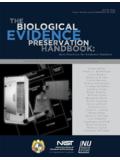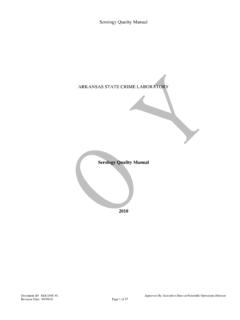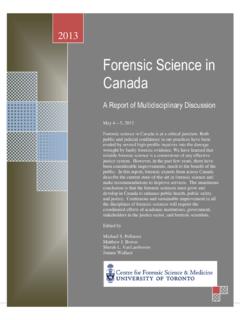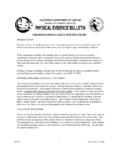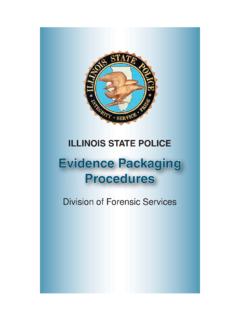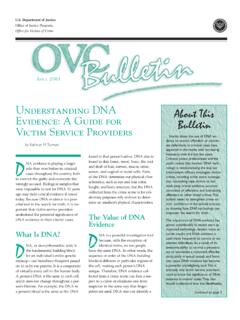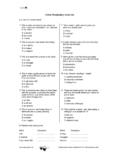Transcription of COLLECTION OF SOIL SAMPLES - Crime Scene …
1 BFS 23 PEB 13 (Rev. 8/89)1 COLLECTION OF soil SAMPLESINTRODUCTION:Naturally occurring soil is a complex and changing mixture of living organisms, decaying organic matter,air, water, and relatively stable rock and mineral fragments such as clay and sand. Although there aremany different types of soils in the state of California, specific local areas contain relatively few of thesevarieties. Each type may exist for a few square yards or for many square miles with the amount ofvariation in a single soil being quite limited. Hence, it is not feasible to exactly pinpoint the origin of aparticular naturally occurring soil sample, but rather to relate it to areas of SAMPLES may also contain debris from human habitation or industrial operations. The latter type ofdebris; , paint droplets, cinders, chemicals or fibers, if sufficiently varied and unique, can be mostvaluable in individualizing a specimen. soil SAMPLES containing such unusual features can be excellentand unexpected physical evidence.
2 Consequently, all soil SAMPLES should be submitted in anticipation thatthis rare occurrence may actually only do the character and composition of soils vary laterally, but also with depth. Unless a Crime iscommitted which involves the digging of a grave, most SAMPLES for soil comparison will be from the topsurface. Although the color and texture of soils visually do not appear to vary along the ground, thechemical composition can change sufficiently in a short distance, so that it may be significant in localizingthe source of the soil sample. Therefore, sufficient SAMPLES should be submitted in order to establish thenormal distribution of soil of a particular type in and about a Crime :Impressions - Insure that impressions in soil such as footprints or tire tread patterns are photographedwith a scale and a plaster cast made before disturbing the footprint in any manner (see PEB 23 Rev. '98).Impression evidence is frequently much more positive than a soil SAMPLES - A tablespoonful is sufficient quantity for a soil comparison.
3 If the soil is firmlyattached to some object do not remove, but AIR DRY and place the object in a paper bag or otherappropriate container, seal and label. Loose soil or sand can be swept onto a clean piece of paper whichis then folded to enclose the specimen and, when completely dried, sealed in an appropriate container, andlabeled as to SAMPLES - Obtain SAMPLES consisting of at least three (3) tablespoonfuls of soil from eacharea where the suspect is known, or is believed to have been at the Scene , including any "alibi" sitesprovided. Comparison SAMPLES must be representative. If, for example, suspect shoes have beenrecovered and soil is present on the shoes, recover a soil sample from the area of the footprint thatBFS 23 PEB 13 (Rev. 8/89)2corresponds to the location of the soil on the shoes. If soil on the shoes appears to be from the surfacewhere the footprints are found, collect surface SAMPLES (top quarter inch).
4 If the soil may be from anexcavation of some type, collect specimens at many different depths and mark the depth at which eachwas is also advisable to collect SAMPLES from other locations in the vicinity of the Crime Scene , so that thelaboratory can determine how much variation there is in the soil of that area. In, for example, a yard,collect from several areas in the yard and also from adjoining property. In open areas the followingsystematic method for recovery of soil SAMPLES can be used:Start at point number 1 (footprint, tire impression, area of obvious scuffle, etc.) and obtain soil samplesat each point, 1 through 13. Each sample should be numbered to correspond with the number on thediagram. Record a description of the physical location from where the soil sample was collected ( ,ditch) and note any unusual conditions in the vicinity ( , close to petroleum tank).Always air dry out damp soil SAMPLES prior to packaging or mold growth will occur.
5 Seal the dry samplein a pill box or vial and label completely as to location recovered, officer collecting, date, time, - Collect SAMPLES as soon after the event as possible, before any changes in the site canoccur. Submit SAMPLES personally or by mail as soon as possible to your nearest Regional CriminalisticsLaboratory.

